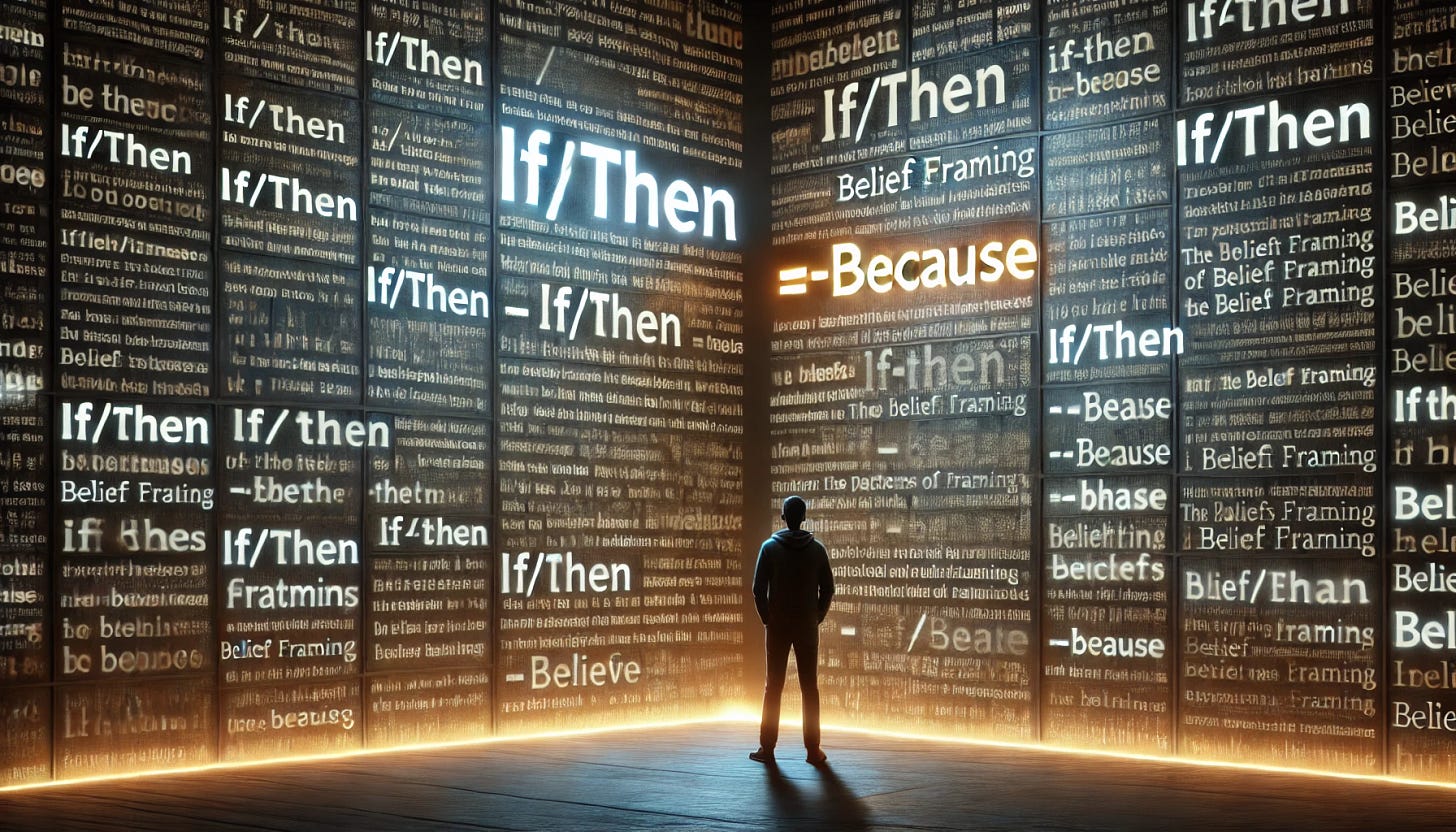🖼️ How Our Beliefs Are Framed Using Language
Our beliefs shape how we see the world, influencing everything from our personal values to our everyday decisions. Often, these beliefs are built around if/then and =because patterns — simple statements that link one idea to another and define how we think reality works.1 "If I fail, then I’m not good enough" or "Success equals money" are common examples of these rigid, limiting structures. While these patterns might seem harmless, they often narrow our perspectives and restrict our potential.
Robert Dilts is a renowned figure in Neuro-Linguistic Programming (NLP) and has been instrumental in advancing techniques that leverage language to influence thought and behavior. He developed Sleight of Mouth as a verbal reframing pattern set to shift beliefs and alter perspectives. The technique emerged from Dilts' extensive work modeling the language patterns of influential thinkers and communicators, including historical figures like Abraham Lincoln, Mahatma Gandhi, Walt Disney, Albert Einstein, and Milton Erickson. By studying how these leaders used language to shape perceptions and drive change, Dilts distilled their strategies into practical, conversational tools that challenge limiting beliefs.
By becoming aware of how if/then=because beliefs show up in our thinking, we can begin to challenge them. You don’t need to learn complex techniques right away. Start by spotting these patterns in your daily life—on social media, in conversations, or even in your own thoughts. Once you’ve identified them, you can gradually explore simple reframes that open up new possibilities, freeing yourself from the limits these beliefs impose.
Thanks to my readers' generosity, all my articles are free to access. Independent journalism, however, requires time and investment. If you found value in this article or any others, please consider sharing or even becoming a paid subscriber, who benefits by joining the conversation in the comments. I want you to know that your support is always gratefully received and will never be forgotten. Please buy me a coffee or as many as you wish.
One powerful technique for using language to shift perspectives and beliefs is Sleight-of-Mouth, a method that helps reframe conversations and challenge limiting ideas. The core of this technique is based on two simple patterns:
If/Then Statements — these assume one thing leads to another (“If X happens, then Y will happen”).
=Because Statements — these assume two things are the same (“X is true because Y is true”).
By carefully looking for these language patterns and examining and questioning these beliefs, we can question our own beliefs, shift someone’s perspective, and even help them adopt more flexible, empowering views.
💡 What is an “If/Then” Belief?
An “If/then” belief creates a conditional link between two ideas: “If this happens, then that must follow.” These beliefs establish rigid rules about how the world works, limiting our understanding of possibilities. In everyday conversation, these beliefs appear in statements that simplify complex situations.
💡 What is a "=Because" Belief?
A "=Because" belief equates two concepts by stating that one is true because of another. These beliefs form direct links between unrelated ideas, creating the impression that one naturally follows from the other. "=Because" beliefs lock individuals into thinking that something is inherently true simply because they connect it to another assumption, often without questioning the validity of the connection. In daily conversation, these beliefs surface when one thing is assumed to automatically define or cause the other, limiting deeper exploration of possibilities.
One of the best online resources to learn hypnotic linguistics is Matteo Morelli’s MindTitans YouTube Channel and Online Courses.
Reframing Example
Let’s explore this technique using the tweet “The only real failure is abandoning your principles” as an example. We’ll see how to reframe this belief using Dilts's 14 different “frames,“ each designed to disrupt the way someone holds onto limiting beliefs.
This example tweet got a) 113.8K views, b) 631 Retweets, and c) 319 bookmarks, which indicates that many of Mr. Holiday’s followers swallow this bait whole. (I tried looking at the 109 comments, but they were mixed with cult followers, critics, eGirls, and spam).
Tweets like this, thus consumed, do not activate the cerebral cortex and go straight to the reptile brain. Do not pass Go; do not collect $200. This pre-packaged axiomatic nonsense is how “wisdom” is sold to the public as a cheap substitute for critical thinking (λόγος). There are big bucks in “deep thoughts.”
(Shameless plug: That said, if you find you get any real value out of this article, feel free to become a paying member).
Holiday’s tweet presents an if/then belief that says if you abandon your principles, then you fail.
It’s also an =because belief because it pre-supposes that failure equals giving up on principles.
While it may seem noble, what if those undefined principles aren’t always correct or helpful? Let’s look at how Sleight-of-Mouth linguistic reframing techniques can shift this belief.
1. Intent Reframe
How it works: This reframe looks at the positive intention behind the belief.
In this case, the tweet suggests that sticking to principles is valuable.
However, what’s the intention behind not abandoning them?
Maybe it’s to stay true to oneself.
A reframe might be:
"Changing your principles can be a sign of growth, not failure, when they no longer serve you."
2. Consequence Reframe
How it works: This focuses on the consequences of holding the belief.
A possible consequence of always sticking to principles, even when they no longer serve you, is missing out on growth.
The reframe could be:
“Sticking to outdated principles could be a bigger failure than abandoning them when they no longer make sense.”
3. Hierarchy of Criteria Reframe
How it works: This reframe introduces a higher value that is more important than the belief.
If the higher value is truth, the reframe might be:
“What if staying true to the facts is more important than sticking to your principles when they turn out to be wrong?”
4. Redefine Terms
How it works: Change the meaning of key terms in the belief.
Here, the term “failure” is crucial.
The reframe could redefine it as:
“Failure isn’t abandoning principles, but refusing to learn and grow beyond them.”
5. Counterexample
How it works: Find an example that contradicts the belief.
Many successful people have adapted their principles when new information came to light.
A reframe might be:
“History is full of people who succeeded precisely because they revised their principles to align with reality.”
6. Metaphor or Analogy
How it works: Use a metaphor or analogy to shift the meaning of the belief.
A helpful metaphor could be:
“Holding onto principles without questioning them is like refusing to change course on a sinking ship — loyalty to the wrong course can sink you.”
7. Change Frame Size
How it works: Expand or reduce the scope of the belief.
Instead of making the issue solely about one person’s principles, broaden the view:
“In the grand scheme of things, adapting principles is part of growing — both personally and culturally.”
8. Apply to Self
How it works: Apply the belief back to the person making the claim.
A reframe here could ask:
“Doesn’t sticking to principles sometimes require changing them to match who you truly are today?”
9. Change Outcome
How it works: Shift the focus to a different outcome than the one being assumed.
The original tweet assumes abandoning principles is the worst outcome. A reframe might be:
“Sometimes, the real success lies in knowing when to abandon principles that no longer serve a positive purpose.”
10. Another Outcome
How it works: Offer a different possible outcome from the same scenario.
Here, instead of equating failure with giving up on principles, suggest a different path:
“Abandoning outdated principles could be the breakthrough needed for true success.”
11. Chunk Up
How it works: Go broader to a more abstract level.
The reframe could look at the broader purpose of principles:
“Principles are tools for guiding behavior, not strict rules to follow at all costs.”
12. Chunk Down
How it works: Focus on the details, making the belief more specific.
Narrow down the tweet to its details:
“Which principles are worth holding onto, and which ones should be reconsidered?”
13. Positive Intention
How it works: Identify the positive intention behind abandoning principles.
In this case, changing principles could have a positive outcome:
“Abandoning principles could be a sign of growth, learning, and flexibility.”
14. Model of the World
How it works: Question the assumption that everyone’s worldview is the same.
Not everyone shares the same principles, and different people have different models of success:
“For someone else, success might be defined by adapting principles to align with new evidence or circumstances.”
🎅🏻 Belief Systems Are Bounded by Faith in the Source
One of the underlying truths about all belief systems is that they rely on faith in the source of the information. Whether it’s a trusted authority, personal experience, or cultural background, people adopt beliefs because they trust the source. When a belief like “The only real failure is abandoning your principles” becomes too rigid or fossilized, it’s often because the person has deep faith in where that principle originated.
If the source of the information (parents, society, mentors, government, “the news,” “experts”) is perceived as infallible, the belief can feel unchangeable. However, challenging faith in the source is another powerful way to reframe beliefs. What happens if the source is mistaken, new information comes to light, or — heaven forbid — lies? Questioning the source of a belief can create an opportunity for new thinking and a shift in perspective.
Conclusion
Learning to recognize the if/then=because pattern is the first step in understanding how these beliefs shape all aspects of our reality. You don’t need to memorize the 14 Sleight-of-Mouth patterns to get started. Begin by identifying these patterns in your daily life—whether in your tweets, social media, or conversations. By simply recognizing how these belief structures work, you open the door to change. From there, you can experiment with reframes, one at a time, and discover which ones work best for you. The power of reframing lies not in complexity but in awareness, allowing you to transform limiting beliefs into more adaptive, flexible perspectives at your own pace.
References
Sleight of Mouth: The Magic of Conversational Belief Change by Robert Dilts
Sleight of Mouth Volume II: How Words Change Worlds by Robert Dilts
CHAT GPT Prompt
Chat-GPT 4o knows sleight-of-mouth! Once you learn to spot the if/then=because patterns, here’s a prompt that you can use to generate the 14 reframes on any if/then=because you see!
Take the following cause-effect complex equivalency and render 14 sleight-of-mouth responses. "[INSERT IF/THEN=BECAUSE STATEMENT HERE]" Here are some examples (click on images for the reframes):
Neurolinguistic Programmers refer to “If/Then” as a “Complex Equivalence” and “=Because” as a “Cause-Effect” pattern. I have taken the liberty of rebranding these terms as a way — using language — to make these ideas more available to a broader audience.












Outstanding article Peter. Critical thinking is very much needed on this subject applied to what folks are sharing on the x-space, among others. Tried with the $5.00/“thought terminating cliche and false dichotomy post”; and, present company excluded, heard only a “faint” choir of crickets … perhaps that’s a good thing. Escapees from Gate’s food drive.😊🌀
So interesting. Thank you.